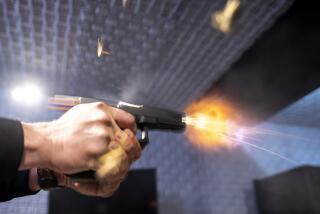At Arm’s Length
- Share via
Roger Sherer lives in a comfortable two-bedroom home in Westwood. He has a high-tech alarm system with a panic button by his bed. He has a car alarm system that scolds you if you come too close to his BMW. He insists that his wife carry a canister of pepper spray attached to her key chain. And just in case, the 39-year-old Sherer keeps a gun in the house.
“Frankly,” he says, “I know nothing is foolproof, but I feel safer this way.” Sherer has never been a victim of crime, but like many other Angelenos, he shapes his life around fear of it.
Statistics show that violent crime has gone down in major cities, Los Angeles included. But in the meantime, the $13-billion-a-year security industry has boomed. Experts agree that even the most sophisticated alarm system can be disabled, but they also point out that self-defense products and alarm systems do offer some sense of security and can act as deterrents.
Here is a sampling of some of the newest items you can purchase in the quest for self-protection.
*
Home Alarms: They are so popular that security companies have virtually tapped out the home market, says Jack Ross, vice president of SOLA-Security of Los Angeles. Ross says a very basic system offering a sensor monitor and wiring on front and back doors can cost as little as nothing to install and $20 to $30 in monthly monitoring fees. This is what Ross calls a “cheap date,” largely ineffectual because burglars seldom come in through front doors.
He recommends spending $1,500 to $5,000 to wire all entry doors, secure key windows and install motion sensors. Perks are a panic button, preferably audible, for dire emergency.
*
Car Alarms: For $99 you get a basic alarm that wails. If you’re serious about preventing someone from driving your car away, figure on spending $300 and get a hood lock, which prevents a thief from disabling the alarm. Another option is a starter disabling system.
*
Anti-Carjacking Systems: One solution (for about $250) is a system that disables the vehicle about two blocks after the thief has driven it. The best systems are activated automatically when the driver’s door is opened and must be disabled by pushing a switch a certain number of times.
*
Anti-Code Grabbing Systems: They are the antidote to electronic “code grabbers,” gadgets that record signals from garage door-openers, car alarms and other remote devices. Once a signal is recorded, the burglar plays it back and opens whatever was locked. Consider a system that rotates or skips codes every time the remote is pressed. Cost: $300 and up.
*
Odor Rape Deterrent: This tiny capsule is touted as a nonviolent deterrent to rape and assault. When the victim is in danger, all she does is squeeze the capsule, which emits such a foul odor that the attacker, it’s hoped, flees. With the advent of rohypnol, the so-called rape drug, the capsule is being advertised as a last resort defense. Repulse rape deterrent (the active ingredient is Butyl Mercaptan) is sold via the Internet by Self Defense Products (https://www.selfdefenCe.com).
*
Pepper Spray: Pepper spray is probably the most popular self-defense item. It is cheap (usually between $10 and $15), does not require a license or training, is easy to find (available in hardware and drugstores) nonlethal, can be sprayed from a distance and, if used properly, actually works. The idea is to reduce the assailant to a mass of coughing, choking and teary eyes for up to 30 minutes. For a bit more money, foggers--pepper spray with a dye--will turn your assailant bleary-eyed and purple or green.
*
Stun Guns: These are battery-operated hand-held devices that produce an electronic discharge ranging from 65,000 volts that cause painful muscle spasms to 200,000 volts that will leave your assailant dazed and with no muscle control for up to 10 minutes. They’re surprisingly inexpensive (the 200,000-volt model sells for as little as $50), scary-looking, painful to the attacker and nonlethal. But you have to touch the bad guy with the gun.
*
Air Tasers: As recently as last year, these were limited to police use in California. Now, for a little more than $200, you can purchase a Taser, a hand-held baton-like apparatus that uses compressed air to launch two electrically charged hooks attached to 15-foot-long wires. The hooks penetrate clothing and rapidly stun the assailant, incapacitating him for as long as 15 minutes. But if you stand too close or too far, the Taser is not as effective.
*
Personal Alarms: These tiny alarms fit in the palm of your hand and are really, really loud. Most of them are activated by pulling a safety plug and retail for as little as $10.
*
The Bottom Line: If you are bent on self-defense, at the very least get training on whatever device you’re using, says Sgt. Reid Morthel, who heads the Los Angeles Police Department’s Crime Prevention Section. But, he adds, “if a self-defense device makes you feel more comfortable, then carry it. Part of crime prevention is awareness and demeanor, and if you feel secure you are less likely to be a target.”
More to Read
Inside the business of entertainment
The Wide Shot brings you news, analysis and insights on everything from streaming wars to production — and what it all means for the future.
You may occasionally receive promotional content from the Los Angeles Times.










